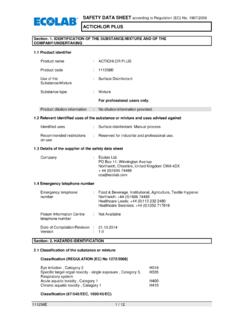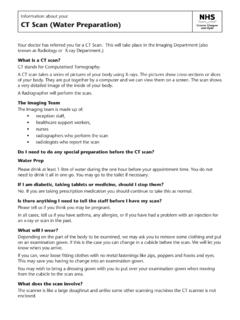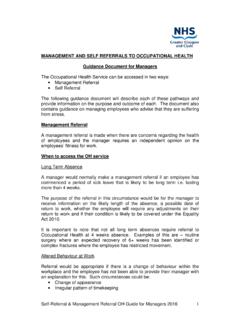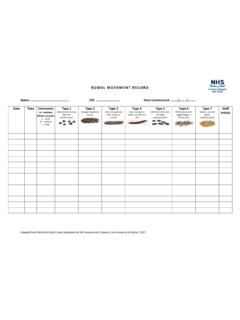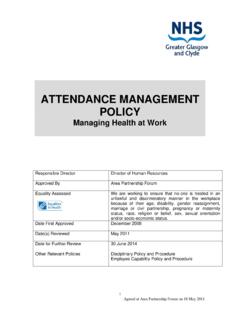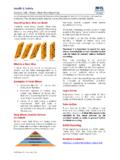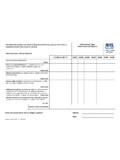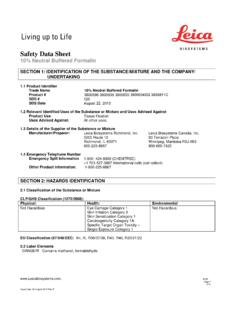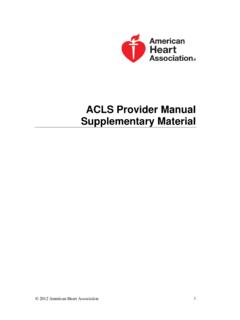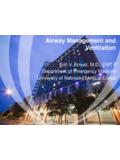Transcription of HEALTH & SAFETY MANAGEMENT MANUAL - …
1 HEALTH & SAFETY MANAGEMENT MANUAL H&S MANAGEMENT MANUAL Page 1 of 25 May 2012 HEALTH & SAFETY MANAGEMENT MANUAL Contents:- Introduction HEALTH & SAFETY MANAGEMENT Legal Framework Managing HEALTH & SAFETY Key Elements of Successful HEALTH & SAFETY MANAGEMENT HEALTH & SAFETY Responsibilities HEALTH & SAFETY Committees Instruction, Information & Training Incident MANAGEMENT Occupational HEALTH Services HEALTH & SAFETY Risk MANAGEMENT Risk Assessment Risk Registers Workplace - HEALTH , SAFETY & Welfare HEALTH SAFETY Welfare H&S MANAGEMENT MANUAL Page 2 of 25 May 2012 Introduction Accidents and ill HEALTH can ruin lives. They can also result in increased costs due to equipment damage, increased insurance costs, loss of expertise and could ultimately result in court summons, financial penalties or custodial sentences.
2 Good HEALTH & SAFETY performance is not only a legal requirement; it is an essential element in both the overall performance and accountability of the organisation and also a contributory factor in our goal of being an exemplar employer. Therefore, good HEALTH and SAFETY performance also makes sound business sense. In addition to protecting our employees and others from the suffering caused by accidents and ill HEALTH , it also helps maintain our reputation, retain staff, improve efficiency and avoid/reduce the costs of accidents and ill HEALTH . This HEALTH & SAFETY MANUAL is designed as a tool to assist managers in controlling HEALTH & SAFETY risks within their department/area of responsibility and is based on the 5 key elements of managing HEALTH & SAFETY as published in HEALTH & SAFETY Executive guidance.
3 These key elements are; H&S MANAGEMENT MANUAL Page 3 of 25 May 2012 Section - HEALTH & SAFETY MANAGEMENT Legal Framework The basis for HEALTH & SAFETY law in Great Britain is the HEALTH & SAFETY at Work etc Act 1974 (HSWA) which sets out, amongst other provisions, general duties for both employers and employees. These are summarised below; Employers must Provide and maintain safe systems of work ( procedures & equipment) Ensure safe handling, storage, transport and use of substances Provide information, instruction, training and supervision to ensure the HEALTH and SAFETY at work of all employees Provide and maintain a safe working environment Employees must Take care of their own HEALTH and SAFETY and the HEALTH and SAFETY of others who may be affected by their acts or omissions Co-operate with their employer in HEALTH and SAFETY matters Not misuse or interfere with anything provided for HEALTH and SAFETY purposes These duties are qualified by the term so far as is reasonably practicable.
4 'Reasonably practicable' means the measures taken to avoid or control risks should be in proportion to that risk balancing the cost of steps taken to reduce a risk against the degree of risk presented. Cost should include the time, trouble and effort required, not just the financial cost. Since the introduction of HSWA, numerous sets of regulations have been introduced, many aimed at hazards that can be encountered within the NHS, hazardous substances, work equipment, MANUAL handling, working with computers. Many of these regulations outline absolute duties and do not allow for reasonably practicable . The MANAGEMENT of HEALTH & SAFETY at Work Regulations 1999 (the MANAGEMENT Regulations) introduced more explicit requirements of employers to effectively manage HEALTH & SAFETY risks.
5 Like HSWA, they apply to all work activity. The MANAGEMENT Regulations require employers to: make appropriate HEALTH and SAFETY arrangements employ competent HEALTH and SAFETY assistance lay down appropriate procedures for serious and imminent danger provide information for employees provide appropriate HEALTH surveillance where necessary provide for co-operation and co-ordination of HEALTH and SAFETY arrangements for contractors and self-employed people working within his operation have due consideration for individual capabilities and training with regard to HEALTH and SAFETY . H&S MANAGEMENT MANUAL Page 4 of 25 May 2012 The main requirement is the undertaking of risk assessment which must: a) Be systematic b) Identify hazards c) Evaluate the likelihood and severity of risks This undertaking will be explained in more detail in Section - HEALTH & SAFETY Risk MANAGEMENT .
6 The Workplace ( HEALTH , SAFETY and Welfare) Regulations 1992, as amended, expand on the duties placed on employers under HSWA to provide and maintain a safe working environment. Commonly known as the Workplace Regulations, they apply to all NHSGGC premises and are intended to protect the HEALTH & SAFETY of everyone in the workplace (not only employees) and ensure that adequate welfare facilities are provided for people at work. The term workplace applies to common areas of shared buildings and includes private roads, paths and other outdoor areas under NHSGGC control. What you are required to do with regards to the Workplace Regulations will be explained further in Section - Workplace.
7 H&S MANAGEMENT MANUAL Page 5 of 25 May 2012 Managing HEALTH & SAFETY Key Elements of Successful HEALTH & SAFETY MANAGEMENT The key elements of successful HEALTH and SAFETY MANAGEMENT are set out in this summary. The five elements form the basis for this MANUAL . Policy Effective HEALTH and SAFETY policies set a clear direction for the organisation to follow. They contribute to all aspects of HEALTH care as part of a commitment to continuous improvement. They also recognise that there are cost effective approaches to preserving and developing physical resources and staff, which reduce financial loss and liabilities. HEALTH & SAFETY Policies are available here Organising An effective MANAGEMENT structure and arrangements are in place for the delivery of the policy.
8 Managers must motivate staff to work safely and to protect their long-term HEALTH , not just simply to avoid incidents. This will also include the SAFETY of patients and others. The manager should use this MANUAL in partnership, working locally with staff, their Representatives and specialist Advisors to improve HEALTH and SAFETY within their area of control. A positive HEALTH & SAFETY culture is fostered by the visible and active leadership of managers at all levels within the organisation. Planning There is a planned and systematic approach to implementing policies through an effective HEALTH and SAFETY MANAGEMENT System aimed at minimising risks for all. Managers should ensure that they, or a competent deputy, receive training in the methodology of risk assessment.
9 Risk assessments are used to decide on priorities and set objectives for eliminating hazards and reducing risks (see Section ). All significant risks should be included in the local risk register (see Section ). Measuring performance Performance is measured against agreed standards to establish when and where improvement is needed. Managers should actively monitor their own performance, which includes reviewing documentation, carrying out workplace inspections, completion of workplace hazard checklists, risk assessments and setting clear objectives based on their outcome. The aim is to look at both hardware (premises, equipment and substances) and software (people, procedures and systems) including individual behaviour and performance.
10 H&S MANAGEMENT MANUAL Page 6 of 25 May 2012 Manager s Annual Self Audit Form has been designed for managers to measure the performance of their department annually. The aim of the audit is to identify areas for improvement as well as where you are compliant, it should not be viewed simply as a point scoring or tick box exercise. Auditing and reviewing performance You and your staff can learn from all relevant experience and apply the lessons. You and your staff should regularly review what has happened based on the active monitoring of the department/ward and any independent audit by others HEALTH & SAFETY Committees, specialist Advisors. Where controls fail, reactive monitoring attempts to discover why by investigating incidents, complaints, claims or ill HEALTH .
